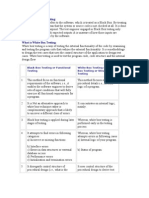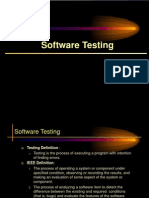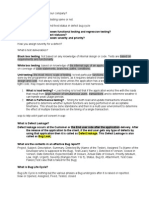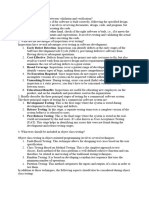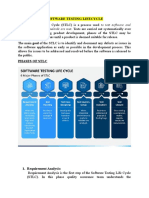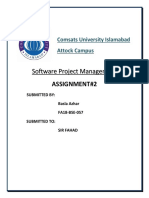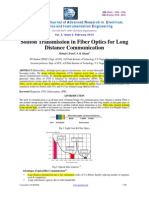SQA&T
SQA&T
Uploaded by
Sharat RamCopyright:
Available Formats
SQA&T
SQA&T
Uploaded by
Sharat RamCopyright
Available Formats
Share this document
Did you find this document useful?
Is this content inappropriate?
Copyright:
Available Formats
SQA&T
SQA&T
Uploaded by
Sharat RamCopyright:
Available Formats
I M.
Tech I Semester II Mid Examinations (2010 11) SOFTWARE QUALITY ASSURANCE & TESTING
1. Explain white box and black box testing and specify differences
(Software Engineering)
between them?
Black-box testing is a method of software testing that tests the functionality of an application. Specific knowledge of the application's code/internal structure and programming knowledge in general is not required. The tester is only aware of what the software is supposed to do, but not how i.e. when he enters a certain input, he gets a certain output; without being aware of how the output was produced. Black-box testing, also called behavioral testing, focuses on the
functional requirements of the software. That is, black-box testing enables the software engineer to derive sets of input conditions that will fully exercise all functional requirements for a program. Black-box testing attempts to find errors in the following categories:
1. 2. 3. 4. 5.
Incorrect or missing functions, Interface errors, Errors in data structures or external database access Behavior or performance errors, and Initialization and termination errors.
There are various techniques in developing test cases for black box testing. Equivalence Partitioning, BVA (Boundary Value Analysis) and Cause-Effect are different methods of black box testing. Equivalence partitioning is a black-box testing method that divides the input domain of a program into classes of data from which test cases can be derived. Equivalence classes may be defined according to the following guidelines: 1. If an input condition specifies a range, one valid and two invalid equivalence classes are defined. 2. If an input condition requires a specific value, one valid and two invalid equivalence classes are defined. 3. If an input condition specifies a member of a set, one valid and one in valid equivalence class are defined. 4. If an input condition is Boolean, one valid and one invalid class are defined. Boundary Value analysis: Cause Effect Graphing: Cause Effect Graphing is a software test design technique that involves identifying the cases (input conditions) and effects (output conditions), producing a Cause-Effect Graph, and generating test cases accordingly Advantages of Black Box Testing - Tester can be non-technical.
- Used to verify contradictions in actual system and the specifications. - Test cases can be designed as soon as the functional specifications are complete.
White Box Testing: White-box testing (also known as clear box testing, glass box testing, transparent box testing, and structural testing) is a method of testing software that tests internal structures or workings of an application, as opposed to its functionality (i.e. black-box testing). In white-box testing an internal perspective of the system, as well as programming skills, are used to design test cases. The tester chooses inputs to exercise paths through the code and determine the appropriate outputs. This is analogous to testing nodes in a circuit, e.g. incircuit testing (ICT). While white-box testing can be applied at the unit, integration and system levels of the software testing process, it is usually done at the unit level. It can test paths within a unit, paths between units during integration, and between subsystems during a systemlevel test. Though this method of test design can uncover many errors or problems, it might not detect unimplemented parts of the specification or missing requirements. White-box test design techniques include: Control flow testing Data flow testing Branch testing Path testing Black Box Testing White Box Testing
Criteria
Definition
Black Box Testing is a software White Box Testing is a software testing method in which the internal testing method in which the internal structure/ design/ implementation of structure/ design/ implementation of the item being tested is NOT known the item being tested is known to to the tester the tester. Mainly applicable to higher levels of testing: Acceptance System Testing Mainly applicable to lower levels of testing: Unit Integration Testing Generally, Software Developers
Levels Applicable To
Responsibility Programming Knowledge
Generally, independent Software Testers Not Required
Required
Implementation Knowledge Basis for Test Cases
Not Required
Required
Requirement Specifications
Detail Design
2. Explain Performance testing and Adhoc testing.
Performance Testing:
Performance testing is the process of determining the speed or effectiveness of a computer, network, software program or device. This process can involve quantitative tests done in a lab, such as measuring the response time or the number of MIPS (millions of instructions per second) at which a system functions. Qualitative attributes such as reliability, scalability and interoperability may also be evaluated. Different types of performance Testing: Load testing Load testing is the simplest form of performance testing. A load test is usually conducted to understand the behavior of the system under a specific expected load. This load can be the expected concurrent number of users on the application performing a specific number of transactions within the set duration. This test will give out the response times of all the important business critical transactions. If the database, application server, etc. are also monitored, then this simple test can itself point towards any bottlenecks in the application software. Stress testing Stress testing is normally used to understand the upper limits of capacity within the system. This kind of test is done to determine the system's robustness in terms of extreme load and helps application administrators to determine if the system will perform sufficiently if the current load goes well above the expected maximum. Endurance testing (soak testing) Endurance testing is usually done to determine if the system can sustain the continuous expected load. During endurance tests, memory utilization is monitored to detect potential leaks. Also important, but often overlooked is performance degradation. That is, to ensure that the throughput and/or response times after some long period of sustained activity are as good as or better than at the beginning of the test. It essentially involves applying a significant load to a system for an extended, significant period of time. The goal is to discover how the system behaves under sustained use. Spike testing Spike testing is done by suddenly increasing the number of, or load generated by, users by a very large amount and observing the behavior of the system. The goal is to determine
whether performance will suffer, the system will fail, or it will be able to handle dramatic changes in load. Configuration testing Rather than testing for performance from the perspective of load, tests are created to determine the effects of configuration changes to the system's components on the system's performance and behavior. A common example would be experimenting with different methods of load-balancing. Isolation testing Isolation testing is not unique to performance testing but a term used to describe repeating a test execution that resulted in a system problem. Often used to isolate and confirm the fault domain. Adhoc Testing:
This type of testing is done without any formal Test Plan or Test Case creation. Ad-hoc testing helps in deciding the scope and duration of the various other testing and it also helps testers in learning the application prior starting with any other testing. It is the least formal method of testing. Advantages: We check the application randomly so we reduce time consuming. 1. 2. 3. 4. Ad-hoc Testing is very cost effective Ad-hoc Testing can be followed even when documentation is not present for the system Ad-hoc Testing can be adjusted and done as per the budget Ideal for small size companies
Disadvantage: We will check the application randomly so we miss some activities. So there is chance of bugs in that activity.
3.
Write about software quality metrics.
4.
Explain Test management plan. Scope Of the project: Objective of the testing
In scope: What to test Out Scope: what not to test Software &Hardware Requirements: Training Requirements: Types of testing: Functional: Integration, re-testing, regression Non functional: UI, Performance, security, system testing Staffing: Resource planning Contacts: Test lead. Test man Risks & Mitigations: Defect Reporting Mechanism: Exit Criteria: No defect with p1 or p2 while rolling the application to production Test closure activities: what will be delivered, test report test plan Acronyms & Abbreviations:
5. Discuss the role of software testing coverage criteria in testing control. Requirements traceability matrix The term Test Coverage used in the context of programming / software engineering refers to measuring how much a software program has been exercised by tests. Coverage is a means of determining the rigour with which the question underlying the test has been answered. There are many kinds of test coverage: Code coverage, Feature coverage, Scenario coverage, Screen item coverage Model coverage.
Each of these coverage types assumes that some kind of baseline exists which defines the system under test. The number of types of test coverage therefore varies as the number of ways of defining the system. For example, in code coverage: Has a particular statement ever been executed?
How many times has a statement been executed? Have all the statements in a program been executed, at least once? Have all the decision points in the code been exercised such that every decision path has been taken? Has the last optimization reduced the instruction path length significantly?
(b). Write about automated tools for software testing. Functional: QTP, Test partner, Selenium, Test runner. Performance: QA load, load runner, rational performance, J meter
QTP: HP QuickTest Professional is automated testing software designed for testing various software applications and environments. It performs functional and regression testing through a user interface such as a native GUI or web interface. It works by identifying the objects in the application user interface or a web page and performing desired operations (such as mouse clicks or keyboard events); it can also capture object properties like name or handler ID. HP QuickTest Professional uses a VBScript scripting language to specify the test procedure and to manipulate the objects and controls of the application under test.
Drawbacks: HP QuickTest Professional runs only in Windows environments. It relies on largely obsolete Windows-only technologies such as ActiveX.QTP cannot test with all browser types and versions. In particular it does not support Safari, or Opera. High licensing costs often mean that the tool is not widely used in an organization. Exception handling HP QuickTest Professional manages exception handling using recovery scenarios; the goal is to continue running tests if an unexpected failure occurs. Because HP QuickTest Professional hooks into the memory space of the applications being tested, some exceptions may cause HP QuickTest Professional to terminate and be unrecoverable. Data-driven testing HP QuickTest Professional supports data-driven testing. For example, data can be output to a data table for reuse elsewhere. Data-driven testing is implemented as a Microsoft Excel workbook that can be accessed from HP QuickTest Professional. HP QuickTest Professional has two types of data tables: the Global data sheet and Action (local) data sheets. The test steps can read data from these data tables in order to drive variable data into the application under test, and verify the expected result. Automating custom and complex UI objects
HP QuickTest Professional may not recognize customized user interface objects and other complex objects. Users can define these types of objects as virtual objects. HP QuickTest Professional does not support virtual objects for analog recording or recording in low-level mode. 6. Explain project process standards. There are several project process standards followed by different organizations. A few of them were discussed below.
ISO 9000-3: ISO 9000 [ISO91] supplies a set of standards for quality management of production activities. Organizations are supposed to set up a quality system in order to supervise all phases of a production and delivery process. Some of the activities carried out by the quality system are:a) Auditing the projects to ensure that quality controls are respected, b) Improving the quality system itself, and c) Providing input to the development group, such as new notations, procedures and Standards producing reports to the high-level management.
PSS-05: Practices in PSS-05 are mandatory, recommended or guiding. A mandatory practice must be followed without exception in all software projects. Recommended practices may or may not be followed. However, a justification has to provide if a recommended practice is abandoned. Guideline practices are less crucial; no justification is needed if they are not followed.
PSS-05 does not prescribe a particular lifecycle model. However, any lifecycle model adopted for a project must be defined in a software project management plan and must include the following mandatory phases:a) Definition of user requirements, b) Definition of software requirements, c) Definition of architectural design, d) Detailed design and production of code, e) Transfer of the software to operations, and
f) Operations and maintenance
CMMI [Capability Maturity Model]: Capability Maturity Model Integration (CMMI) is a process improvement approach whose goal is to help organizations improve their performance. CMMI can be used to guide process improvement across a project, a division, or an entire organization. Currently supported is CMMI Version 1.3. CMMI in software engineering and organizational development is a process improvement approach that provides organizations with the essential elements for effective process improvement. CMMI is registered in the U.S. Patent and Trademark Office by Carnegie Mellon University.
7. Explain SQA unit. SQA unit structure varies by type and, of course, size of the organization. As it is impossible to describe all the optional arrangements, the chapter presents a model whose structure and task distribution are readily adaptable to the characteristics and procedures characterizing the internal environment of a spate of major organizations.
The head of the SQA unit is responsible for all the quality assurance tasks performed by the SQA unit and its sub-units. In addition, some SQA tasks are assigned only to him: this allocation reflects the managers professional Experience and administrative position. The typical tasks performed by an SQA unit head may be classified into the following categories: Planning Management of the unit Tasks related to contacts with customers and other external bodies as well as with the executive in charge of software quality SQA professional activities
You might also like
- Assignment of Software Test PlanDocument15 pagesAssignment of Software Test Plankafeel afridi100% (1)
- Automated Software Testing Interview Questions You'll Most Likely Be AskedFrom EverandAutomated Software Testing Interview Questions You'll Most Likely Be AskedNo ratings yet
- ST Unit-3Document32 pagesST Unit-3oxnine2233No ratings yet
- TestingDocument66 pagesTestingSankalp SunilNo ratings yet
- Testing Methods: Software Testing Is An Investigation Conducted To Provide Stakeholders WithDocument7 pagesTesting Methods: Software Testing Is An Investigation Conducted To Provide Stakeholders WithPrabhakar LalNo ratings yet
- Types of Testing:: Frequently Asked QuestionsDocument9 pagesTypes of Testing:: Frequently Asked QuestionsNaveen VarmaNo ratings yet
- Types of Testing:: Frequently Asked QuestionsDocument9 pagesTypes of Testing:: Frequently Asked QuestionsNaveen VarmaNo ratings yet
- Software Testing Is A Process of Verifying and Validating That ADocument61 pagesSoftware Testing Is A Process of Verifying and Validating That Asv0093066No ratings yet
- Black and White Box TestingDocument9 pagesBlack and White Box TestingImran UllahNo ratings yet
- Types of Testing:: Frequently Asked QuestionsDocument9 pagesTypes of Testing:: Frequently Asked QuestionsNaveen VarmaNo ratings yet
- Software Testing MethodsDocument45 pagesSoftware Testing MethodssahajNo ratings yet
- Black Box TestingDocument6 pagesBlack Box TestingGeethrose JosephNo ratings yet
- Croma Campus - Software Quality Testing CourseV4.0Document39 pagesCroma Campus - Software Quality Testing CourseV4.0Nooriya ShaikhNo ratings yet
- Introduce To Software Validation & TestingDocument15 pagesIntroduce To Software Validation & TestingVishal KushwahaNo ratings yet
- Software Testing Question BankDocument17 pagesSoftware Testing Question BankPusba NathanNo ratings yet
- Introduction To TestingDocument30 pagesIntroduction To Testingkishore234No ratings yet
- V Life CDocument9 pagesV Life Cush_ush_ush2005No ratings yet
- SE Unit 4Document40 pagesSE Unit 4AnanthNo ratings yet
- Software Testing: Why Testing Is Important?Document10 pagesSoftware Testing: Why Testing Is Important?priy@nciNo ratings yet
- Unit Testing With JUnitDocument13 pagesUnit Testing With JUnitBiswajit RoyNo ratings yet
- Testing and DebuggingDocument90 pagesTesting and DebuggingNalini RayNo ratings yet
- Unit-1 STDocument74 pagesUnit-1 STShilpa GowdaNo ratings yet
- Ex No:7 Case Study On Software Testing 20.1.2012Document6 pagesEx No:7 Case Study On Software Testing 20.1.2012suk9999No ratings yet
- Imp QuestionsDocument34 pagesImp Questionsshubham ahireNo ratings yet
- QA Interviev Questions 150Document36 pagesQA Interviev Questions 150Алена АлексеенкоNo ratings yet
- Unit I Testing Techniques & Test Case DesignDocument93 pagesUnit I Testing Techniques & Test Case DesignPaviNo ratings yet
- OATS - Oracle Application TestingDocument4 pagesOATS - Oracle Application TestingAbhinavNo ratings yet
- Software TestingDocument51 pagesSoftware Testingjeyaseelan100% (19)
- Software TestingDocument12 pagesSoftware Testingtalibhassan1122No ratings yet
- Unit 4 SEDocument8 pagesUnit 4 SEAnurag SharmaNo ratings yet
- SE Quality Management1 PDFDocument5 pagesSE Quality Management1 PDFPro StalkerNo ratings yet
- Implementation of Software Testing Using Any LanguageDocument14 pagesImplementation of Software Testing Using Any LanguageaddssdfaNo ratings yet
- Software Testing NotesDocument25 pagesSoftware Testing NotesGanesh Kumar PothinaNo ratings yet
- Softeware Testing TechniquesDocument7 pagesSofteware Testing TechniquesSugandh Gupta100% (1)
- What Is Black Box TestingDocument4 pagesWhat Is Black Box TestingAnand MishraNo ratings yet
- SE Unit-IVDocument15 pagesSE Unit-IV6682 BhanuNo ratings yet
- Software Testing 2Document48 pagesSoftware Testing 2Geraldine Cabrera Siega100% (1)
- Ms TestingDocument62 pagesMs Testingmansha99No ratings yet
- ECNG 1009 - Lab 2 Yr 2020Document35 pagesECNG 1009 - Lab 2 Yr 2020Jordan LakeNo ratings yet
- FAQ Software TestingDocument18 pagesFAQ Software Testingarobin777No ratings yet
- Manual TestingDocument4 pagesManual TestingAndreea LilianaNo ratings yet
- Cs502pc Se Unit 4Document14 pagesCs502pc Se Unit 4kingomsriNo ratings yet
- 6.1. TestingDocument12 pages6.1. TestingshubhamNo ratings yet
- Unit IiDocument100 pagesUnit IiVani BaskaranNo ratings yet
- STQA Question BankDocument26 pagesSTQA Question BankBibhukanta DhalNo ratings yet
- Sidra Arooj Software Quality Assurance AssignmentDocument20 pagesSidra Arooj Software Quality Assurance Assignment001stylev001No ratings yet
- Manual TestingDocument7 pagesManual TestingvenugopalNo ratings yet
- Software TestingDocument20 pagesSoftware TestingssertfyjNo ratings yet
- Software Testing SefaDocument3 pagesSoftware Testing Sefashahalameenu2003No ratings yet
- Ch8 Quiz Group2Document4 pagesCh8 Quiz Group2buitrungnhan4858No ratings yet
- Conversion Gate01Document41 pagesConversion Gate01Anonymous S5fcPaNo ratings yet
- Software Testing LifecycleDocument29 pagesSoftware Testing LifecycleKAVIPRIYA M SNo ratings yet
- Testing Int QuestionsDocument33 pagesTesting Int QuestionsManimalaNo ratings yet
- 100+ Types of Software Testing - CompleteDocument9 pages100+ Types of Software Testing - CompleteJzerr RNo ratings yet
- What Is Manual Testing?Document24 pagesWhat Is Manual Testing?chayyabnNo ratings yet
- Unit-4 Software Testing-BCADocument21 pagesUnit-4 Software Testing-BCASunil NagarNo ratings yet
- Software TestingDocument6 pagesSoftware TestingHaya NaazNo ratings yet
- Software Testing: A Guide to Testing Mobile Apps, Websites, and GamesFrom EverandSoftware Testing: A Guide to Testing Mobile Apps, Websites, and GamesRating: 4.5 out of 5 stars4.5/5 (3)
- Software Testing Interview Questions You'll Most Likely Be AskedFrom EverandSoftware Testing Interview Questions You'll Most Likely Be AskedNo ratings yet
- The Water Horse: Little CetusDocument6 pagesThe Water Horse: Little CetusletoNo ratings yet
- Generator Semnal Alternator - User Manual - Rtp9005s EuDocument30 pagesGenerator Semnal Alternator - User Manual - Rtp9005s EuLa servici La serviciNo ratings yet
- Listening Activity: David CopperfieldDocument2 pagesListening Activity: David CopperfieldAlfredo DiazNo ratings yet
- Aniline MSDSDocument1 pageAniline MSDSSamir KhanNo ratings yet
- Mick McGuire Value Investing Congress Presentation Marcato Capital ManagementDocument70 pagesMick McGuire Value Investing Congress Presentation Marcato Capital ManagementscottleeyNo ratings yet
- Action Planning For ToRs of CMT - XLSX CompleteDocument1 pageAction Planning For ToRs of CMT - XLSX CompleteOSCAR RUHWEZANo ratings yet
- Seven VirtuesDocument37 pagesSeven Virtuesbunnyzeko1No ratings yet
- ILMPDocument1 pageILMPJudy Lyn MahusayNo ratings yet
- 7 Soliton PDFDocument8 pages7 Soliton PDFAnonymous K9F6Z7LwuNo ratings yet
- Advanced SQL PuzzlesDocument91 pagesAdvanced SQL PuzzlesArindam MitraNo ratings yet
- Carlton Faulk, Superintendent: 4th 3rd 2nd 1st EOCDocument1 pageCarlton Faulk, Superintendent: 4th 3rd 2nd 1st EOCDAYLYN DISTONNo ratings yet
- Shaw Channel LineupDocument6 pagesShaw Channel LineupzhukeeNo ratings yet
- PRIMM Replit May 2022Document27 pagesPRIMM Replit May 2022Ben HodsonNo ratings yet
- DLL - Science 6 - Q1 - W8Document3 pagesDLL - Science 6 - Q1 - W8janeNo ratings yet
- DS82 CompleteDocument6 pagesDS82 CompleteBambang WijanarkoNo ratings yet
- Enviroline 124 Application GuidelineDocument12 pagesEnviroline 124 Application GuidelineAhmed IbrahimNo ratings yet
- DTR BHWDocument2 pagesDTR BHWZeezyanNo ratings yet
- Management Presentation: PT Sumber Alfaria Trijaya TBK (As of Sept 30, 2020)Document21 pagesManagement Presentation: PT Sumber Alfaria Trijaya TBK (As of Sept 30, 2020)Putri100% (1)
- Astm D1621-16 (2023)Document3 pagesAstm D1621-16 (2023)wenhsiaochuanNo ratings yet
- Menu of Dances Folk DanceDocument5 pagesMenu of Dances Folk Dancelabortealvin424No ratings yet
- Annual Report Eng 2016 17Document167 pagesAnnual Report Eng 2016 17aditya.patil06198No ratings yet
- Presentasi Seminar IcolliteDocument11 pagesPresentasi Seminar IcolliteAsep SopianNo ratings yet
- Introduction To EvaluationDocument9 pagesIntroduction To EvaluationVeronica GuerraNo ratings yet
- Should A Literature Review Be Written in Past or Present TenseDocument6 pagesShould A Literature Review Be Written in Past or Present Tensec5kby94sNo ratings yet
- Technical Analysis ElearnDocument44 pagesTechnical Analysis ElearnRavi Tomar100% (4)
- 1 Restocking and Grow-Out of Abalone, Taggat Norte MPADocument32 pages1 Restocking and Grow-Out of Abalone, Taggat Norte MPAbeilla swanNo ratings yet
- International Journal of Housing Markets and Analysis: Article InformationDocument22 pagesInternational Journal of Housing Markets and Analysis: Article Information03217925346No ratings yet
- Coffee ShopDocument84 pagesCoffee ShopHrdjjdNo ratings yet
- Leh LadakhDocument5 pagesLeh LadakhRishi JakarNo ratings yet



































